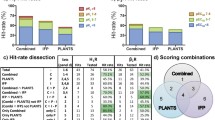Abstract
Until now, the access of ligands into the binding pocket of a G-protein coupled receptor has scarcely been studied using molecular-modeling techniques because of the lack of sufficient algorithms. Neither with Monte-Carlo- nor with Molecular Dynamics Simulations can the penetration of a ligand into the binding pocket of a receptor be calculated because of the excessive amount of computing time needed. Therefore, a new algorithm LigPath for approximate calculation of a ligand’s pathway into the binding pocket has been developed. This new algorithm is based on a linkage of directional guiding of the ligand, Monte-Carlo-Search and minimization. In order to evaluate the performance of the algorithm, the guinea-pig histamine H1 receptor was investigated in combination with one of its potent agonists, histaprodifen, which is proposed to bind in a pocket deep between the transmembrane helices of the receptor. Our calculations show that the amino acids Tyr194, Phe193, Phe436 and Phe433 guide the positively charged histaprodifen from the extracellular part of the receptor into the binding pocket.












Similar content being viewed by others
References
Guilbert C, Perahia D, Mouawad L (1995) Comp Phys Comm 95:263–273
Izrailev S, Stepaniants S, Isralewitz B, Kosztin D, Lu H, Molnar F, Wriggers W, Schulten K (1998) In: Deuflhard P, Hermans J, Leimkuhler B, Mark A E, Reich S, Skeel RD (eds) Computational molecular dynamics: challenges, methods, ideas, volume 4 of lecture notes in computational science and engineering. Springer, Berlin Heidelberg New York, pp 39–65
Isralewitz B, Izrailev S, Schulten K (1997) Biophys J 73:2972–2979
Kosztin D, Izrailev S, Schulten K (1999) Biophys J 76:188–197
Tokarski JS, Hopfinger AJ (1997) J Chem Inf Comput 37:792–811
Biebermann H, Schöneberg T, Schulz A, Krause G, Grüters A, Schultz G, Gudermann (1998) FASEB J 12:1461–1471
Czaplewski C, Kazmierkiewicz R, Ciarkowski J (1998) J Comput Aided Mol Des 12:275–287
Colson A-O, Perlman JH, Smolyar A, Gershengorn M, Osman R (1998) Biophys J 74:1087–1100
Salo OMH, Lahtela-Kakkonen M, Gynther J, Järvinen T, Poso A (2004) J Med Chem 47:3048–3057
Gehlhaar DK, Verkhivker GM, Rejto PA, Sherman CJ, Fogel DB, Fogel LJ, Freer ST (1995) Chem Biol 2:317–324
Gershengorn MC, Osman R (2001) Endocrinology 142:2–10
Barnett-Norris J, Hurst DP, Lynch DL, Guarnieri F, Makriyannis A, Reggio PH (2002) J Med Chem 45:3649–3659
Pardo L, Giraldo J, Martin M, Campillo M (1991) Mol Pharmacol 40:980–987
Gouldson PR, Winn PJ, Reynolds A (1995) J Med Chem 38:4080–4086
Barnett-Norris J, Hurst DP, Buehner K, Ballesteros JA, Guarnieri F, Reggio PH (2002) Int J Quant Chem 88:76–86
Gouldson PR, Kidley NJ, Bywater RP, Psaroudakis G, Brooks HD, Diaz C, Shire D, Reynolds CA (2004) PROTEINS: Struc Func Bioinf 56:67–84
Sai Ram KVVM, Rambabu G, Sarma JARP, Desiraju GR (2006) J Chem Inf Model (published on Web on 09-May-2006)
Elz S, Kramer K, Leschke C, Schunack W (2000) Eur J Med Chem 35:41–52
Menghin S, Pertz HH, Kramer K, Seifert R, Schunack W, Elz S (2003) J Med Chem 46:5458–5470
Seifert R, Wenzel-Seifert K, Bürckstümmer T, Pertz HH, Schunack W, Dove S, Buschauer A, Elz S (2003) J Pharmacol Exp Ther 305:1104–1115
van der Spoel D, Lindahl E, Hess B, van Buuren AR, Apol E, Meulenhoff PJ, Tieleman D P, Sijbers ALTM, Feenstra KA, van Drunen R, Berendsen HJC (2004) GROMACS 3.2. Department of Biophysical Chemistry, University of Groningen, The Netherlands
RCSB PDB Protein Data Bank
Subramaniam S, Henderson R (2000) Nature 406:653–657
Oostenbrink C, Villa A, Mark AE, van Gunsteren WF (2004) J Comput Chem 25:1656–1676
Pedretti A, Vistoli G (1996–2006) VEGA ZZ (Software) http://www.ddl.unimi.it/vega/
Ballesteros JA, Shi L, Javitch JA (2001) Mol Pharmacol 60:1–19
Palczewski K, Kumasaka T, Hori T, Behnke CA, Motoshima H, Fox BA, Le Trong I, Teller DC, Okada T, Stenkamp RE, Yamamoto M, Miyano M (2000) Science 289:739–745
SYBYL 7.0 (2004) Tripos Inc
Baldwin JM, Schertler GFX, Unger VM (1997) J Mol Biol 272:144–164
Gether U (2000) Endocr Rev 21:90–113
Gether U, Kobilka BK (1998) J Bio Chem 273:17979–17982
Kobilka B (2004) Mol Pharmacol 65:1060–1062
Ghanouni P, Steenhuis JJ, Farrens DL, Kobilka BK (2001) Proc Natl Acad Sci USA 98:5997–6002
Luo X, Zhang D, Weinstein H (1994) Prot Eng 7:1441–1448
Author information
Authors and Affiliations
Corresponding author
Rights and permissions
About this article
Cite this article
Straßer, A., Wittmann, HJ. LigPath: a module for predictive calculation of a ligand’s pathway into a receptor-application to the gpH1 - receptor. J Mol Model 13, 209–218 (2007). https://doi.org/10.1007/s00894-006-0152-9
Received:
Accepted:
Published:
Issue Date:
DOI: https://doi.org/10.1007/s00894-006-0152-9




